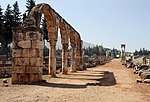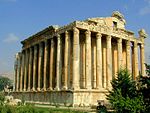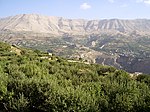This article lists the sites registered with World Heritage to Lebanon.
Understand
the Lebanon ratify the Convention for the Protection of the World Cultural and Natural Heritage on . The first protected sites were inscribed in 1984.
the Lebanon has 5 sites registered with World Heritage, cultural.
The country has also submitted 9 sites to the Tentative List, 8 cultural and 1 natural.
Listing
The following sites are listed as World Heritage.
| Site | Type | Criterion | Description | Drawing | |||||||||||||||||||||
|---|---|---|---|---|---|---|---|---|---|---|---|---|---|---|---|---|---|---|---|---|---|---|---|---|---|
| 1 Anjar | Cultural | (iii), (iv) | The ruins of Anjar, a city founded by Caliph Walid I at the beginning of the 8th century, reveal a very rigorous organization of space similar to that of the palace cities of Antiquity. They constitute a unique testimony to the town planning of the Umayyads. |  | |||||||||||||||||||||
| 2 Baalbek | Cultural | (i), (iv) | This Phoenician city, where the worship of a divine triad was celebrated, was named Heliopolis in the Hellenistic period. It retained its religious function in Roman times when the sanctuary of Jupiter Héliopolitain attracted crowds of pilgrims. With its colossal constructions, Baalbek remains one of the most imposing remains of Imperial Roman architecture at its peak. |  | |||||||||||||||||||||
| 3 Byblos | Cultural | (iii), (iv), (vi) | In Byblos we find the successive ruins of one of the oldest cities in Lebanon, inhabited since the Neolithic era and closely linked to the legend and history of the Mediterranean basin for several millennia. Byblos is directly associated with the history of the diffusion of the Phoenician alphabet. |  | |||||||||||||||||||||
| 4 Wadi Qadisha or Holy Valley and Forest of the Cedars of God (Horsh Arz el-Rab) | Cultural | (iii), (iv) | The Qadisha Valley is one of the most important sites of Christian settlement in the world, and its monasteries, often very old, are set in an extraordinary rugged landscape. Not far from there are the remains of the great cedar forest of Lebanon, very popular in the past for the construction of large religious buildings. |  | |||||||||||||||||||||
| 5 Tyr | Cultural | (iii), (vi) | Tire, where, according to legend, the purple was discovered, was the great Phoenician city mistress of the seas, founder of prosperous counters like Cadiz and Carthage. Its historical role declined at the end of the Crusades. It preserves important archaeological remains, mainly from Roman times. |  | |||||||||||||||||||||
Criteria legend
| |||||||||||||||||||||||||
